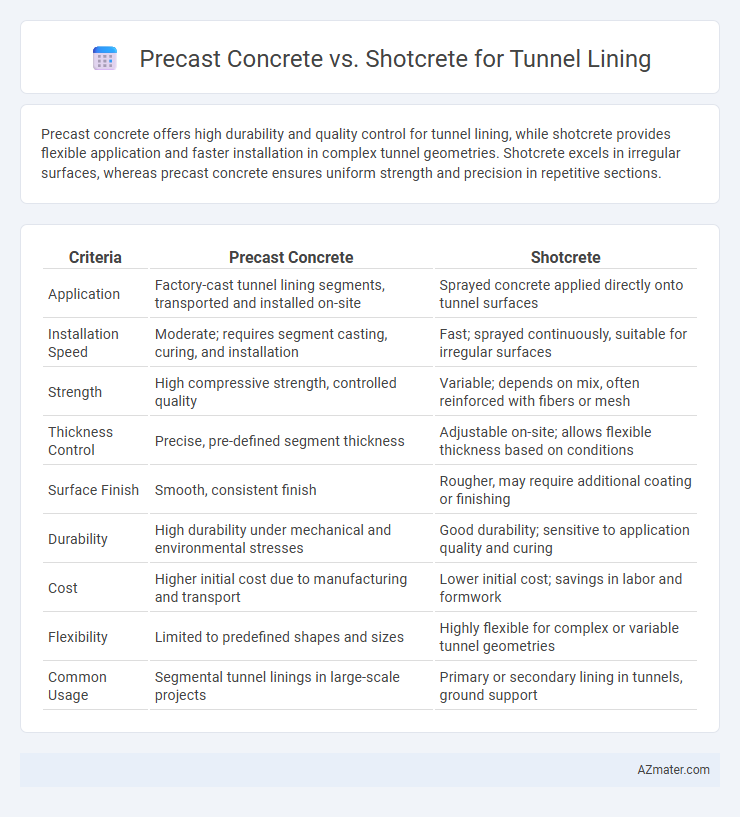Precast concrete offers high durability and quality control for tunnel lining, while shotcrete provides flexible application and faster installation in complex tunnel geometries. Shotcrete excels in irregular surfaces, whereas precast concrete ensures uniform strength and precision in repetitive sections.
Table of Comparison
| Criteria | Precast Concrete | Shotcrete |
|---|---|---|
| Application | Factory-cast tunnel lining segments, transported and installed on-site | Sprayed concrete applied directly onto tunnel surfaces |
| Installation Speed | Moderate; requires segment casting, curing, and installation | Fast; sprayed continuously, suitable for irregular surfaces |
| Strength | High compressive strength, controlled quality | Variable; depends on mix, often reinforced with fibers or mesh |
| Thickness Control | Precise, pre-defined segment thickness | Adjustable on-site; allows flexible thickness based on conditions |
| Surface Finish | Smooth, consistent finish | Rougher, may require additional coating or finishing |
| Durability | High durability under mechanical and environmental stresses | Good durability; sensitive to application quality and curing |
| Cost | Higher initial cost due to manufacturing and transport | Lower initial cost; savings in labor and formwork |
| Flexibility | Limited to predefined shapes and sizes | Highly flexible for complex or variable tunnel geometries |
| Common Usage | Segmental tunnel linings in large-scale projects | Primary or secondary lining in tunnels, ground support |
Introduction to Tunnel Lining Methods
Tunnel lining methods primarily involve precast concrete and shotcrete, each offering distinct advantages based on project requirements. Precast concrete provides uniform quality, faster installation, and enhanced durability through factory-made segments, ideal for large-scale tunnel projects. Shotcrete allows for flexible application directly onto tunnel surfaces, accommodating irregular geometries and providing immediate support in variable geological conditions.
Overview of Precast Concrete in Tunnel Lining
Precast concrete tunnel lining involves manufacturing concrete segments off-site under controlled conditions, ensuring high quality and uniformity. These segments are transported to the tunnel site and assembled to form a continuous lining, providing excellent structural integrity and water tightness. This method allows for rapid installation, reduces on-site labor, and is ideal for repetitive tunnel lining shapes in projects such as metro systems and water tunnels.
Understanding Shotcrete for Tunnel Applications
Shotcrete in tunnel applications offers rapid placement and superior adaptability to complex geometries compared to precast concrete. It provides excellent bonding to uneven surfaces, reducing construction joints and enhancing structural integrity in tunnel linings. Its ability to be applied pneumatically ensures efficient reinforcement embedding and immediate support in challenging excavation environments.
Material Properties: Precast Concrete vs Shotcrete
Precast concrete for tunnel lining exhibits high compressive strength, controlled density, and superior durability due to factory-controlled curing conditions, making it ideal for uniform load-bearing applications. Shotcrete offers rapid application with excellent adhesion and flexibility, accommodating complex geometries and supporting early strength gain, though it may have variable density and porosity influenced by onsite mixing and spray techniques. Material properties of precast concrete emphasize consistency and structural integrity, whereas shotcrete prioritizes adaptability and immediate support in tunneling environments.
Installation Process: Step-by-Step Comparison
Precast concrete tunnel lining involves manufacturing segments off-site, transporting them to the tunnel, and assembling them using heavy machinery, ensuring precise alignment and rapid installation. Shotcrete application requires surface preparation, nozzle spraying of concrete mixture onto tunnel walls, and careful curing, which allows flexibility in irregular shapes but demands skilled labor for consistent thickness and strength. The precast method offers faster, more controlled installation with modular components, while shotcrete provides adaptability for complex geometries and on-site adjustments during tunnel construction.
Durability and Longevity of Lining Systems
Precast concrete tunnel linings offer high durability due to factory-controlled curing processes that ensure uniform strength and reduced permeability, significantly enhancing their longevity in harsh underground environments. Shotcrete provides excellent adhesion and flexibility, allowing for rapid application and seamless integration with irregular tunnel surfaces, which can improve long-term structural integrity by minimizing voids and potential weak points. Both methods resistant to sulfate attack and freeze-thaw cycles, but precast concrete generally exhibits superior resistance to wear and chemical exposure, contributing to extended service life in tunnel linings.
Cost Analysis: Precast Concrete vs Shotcrete
Precast concrete for tunnel lining typically involves higher initial material and manufacturing costs but offers benefits in quality control and installation speed, leading to reduced labor expenses. Shotcrete provides more flexibility in application with lower material costs but can incur higher labor and equipment expenses due to its on-site spraying process and potential rework requirements. Cost analysis must consider project-specific factors, such as tunnel geometry, accessibility, and volume, to determine whether the upfront investment in precast elements or the adaptability of shotcrete yields overall economic efficiency.
Construction Speed and Project Scheduling
Precast concrete offers faster tunnel lining installation with factory-controlled quality, enabling predictable curing times and streamlined on-site assembly that accelerates project scheduling. Shotcrete provides flexibility for irregular tunnel shapes and immediate application but requires longer curing periods and potential rework, which can slow construction speed. Selecting precast concrete typically results in more reliable timelines and reduced labor on-site, optimizing overall project efficiency.
Environmental and Safety Considerations
Precast concrete tunnel lining offers controlled factory conditions that reduce onsite waste and minimize environmental disturbance while ensuring consistent quality and enhanced worker safety by limiting exposure to hazardous dust and fumes. Shotcrete application, although flexible for complex shapes and rapid placement, generates aerosolized particles and rebound waste, necessitating stringent ventilation and protective equipment to mitigate respiratory risks and environmental contamination. Choosing precast concrete or shotcrete depends on balancing environmental impact, site conditions, and occupational safety protocols specific to tunnel construction projects.
Suitability for Various Tunnel Conditions
Precast concrete offers superior quality control and faster installation, making it ideal for tunnels in stable ground conditions where precise segment shaping is required. Shotcrete provides versatility and adaptability, allowing for immediate application on irregular or unstable surfaces and complex tunnel geometries. Tunnel projects involving variable geologies or rapid construction timelines often benefit from combining both methods to maximize structural integrity and efficiency.

Infographic: Precast concrete vs Shotcrete for Tunnel lining
 azmater.com
azmater.com